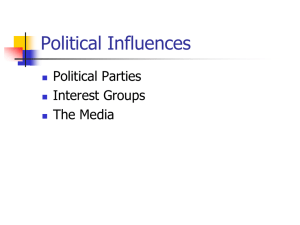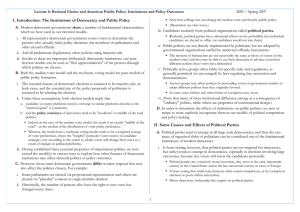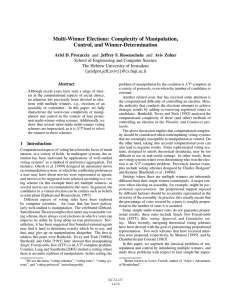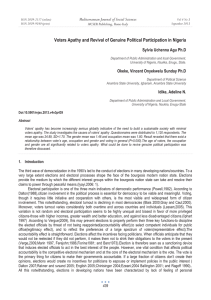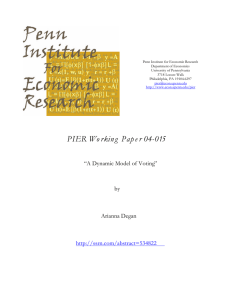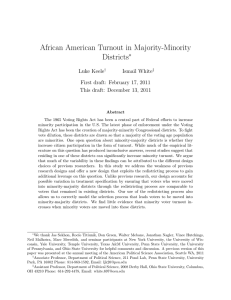Social Groups and Voting: A Comparative View
advertisement
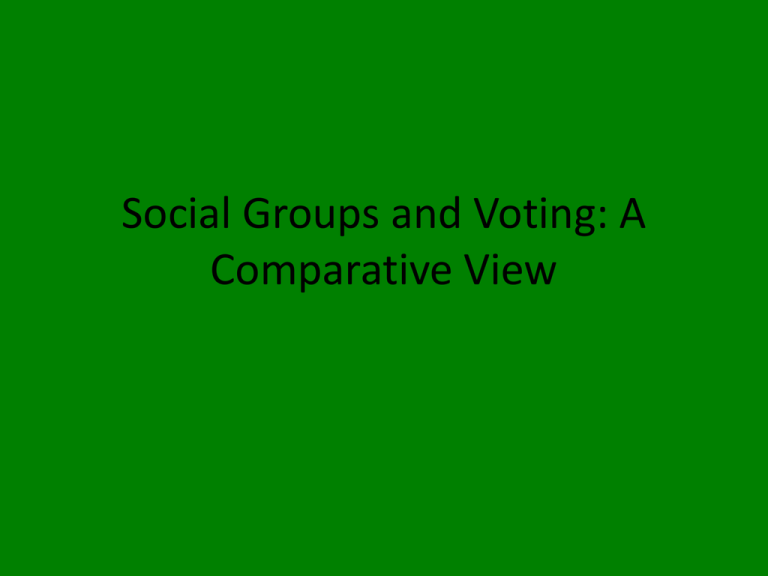
Social Groups and Voting: A Comparative View Who typically votes in Democratic societies? • According to recent research by Jeff Manza & Ruth Braunstein of New York University (2008), in many rich democracies national election turnout is high (80% or more). • In societies with less turnout (60% or less), resources make all the difference. Resource rich groups vote at higher percentages than disadvantaged groups. • In the U.S. a large turnout gap exists (25% or more) between advantaged groups – professionals v unskilled workers – hispanics v whites, and disadvantaged groups. • Not surprisingly, political parties and candidates have significant incentives to pay greater attention to groups with high rates of participation. Resources translate to political power. Recent Voting Trends • There is evidence (despite the 2008 U.S. election) of declining voter turnout in established democracies in the world, since the 1950’s. • Reasons for the decline: • (1). The end of compulsory turnout laws in many countries, or lack of enforcement, ie.; Argentina (weak enforcement) Australia, Belgium (Strict enforcement.) Voting Trends Cont. • (2). Disillusionment among young voters. • (3). Lack of choice—the declining influence of viable left-wing parties, especially in Europe has been a factor. • (4). Declining “social capital” (See studies by Robert Putnam) among various groups: neighborhood associations, unions, community/fraternal groups, etc. Voting Behavior • Rise of “new politics” (away from religion and class) focusing on lifestyles (culture wars), identity, symbolic conflicts (abortion), and national identity have led to some political parties that mobilize voters around these issues: The Green Party in Europe and Right Wing anti-immigration parties (Front National (FN) of Jean Marie le Pen in France for example. • Research on the “new politics” is mixed. Some evidence suggests a decline in voting related to class, although it is not definitive. Social democratic parties in Europe seem to see a slight increase in middle class voters. • Conservative parties are winning votes from nontraditional sources like working class voters (often in response to nationalist or anti-immigrant sentiment or anti-tax, anti-government appeals. Dynamic of Voting Trends. Increased family wealth and social mobility – children of working class parents go to college and change their class identity and increasingly identify with conservative political alignments. Disintegration of working class neighborhoods, weakening of worker solidarity, and economic instability caused by globalization encourage some working voters to support conservative candidates. • Many middle class voters out of concern of social issues, may turn to center-left candidates. • Virtually every Western European country has some form of party with religious roots – Christian Democratic Parties – that possess a center-right political orientation. Politics of Gender • Since the 1980’s, many rich democracies have seen women leaning increasingly to the left of men in many Western European countries and a slight liberal edge in the U.S. • Contributing factors include changing roles of women in the family and society, family instability and exposure to a saturated market place have turned women to the left. Demographic Changes • Declining numbers of unionized, blue collar workers. • Rising share of secular voters across the Western industrial societies. • Expansion of white-collar, non-manual workers has been important. • Aging populations are redefining electoral politics and the issues associated with them. • Immigration has likewise created a new dynamic and will create new electoral alignments as the children of immigrants become citizens, just about everywhere. • 1972 – Hispanics were 3% of the U.S. population. Today they are over 10% of the population. By the middle of the century they will be 25% of the population. • Result of Hispanic voters – immigration policy, labor rights, and healthcare reform have been addresses by both major U.S. parties. Conclusion • As electoral coalitions change, party platforms and campaign strategies will have to change accordingly. • Left of center parties will have to solidify their support of women and ethnic minorities to replace the loss of blue collar voters. • Center Right parties will have to make a concerted effort to increase the numbers of minorities and women candidates and party workers. They may also have to develop more moderate views on immigration and healthcare. Reference • Jeff Manza & Ruth Braunstein (2008), Beyond the Ballet Box: Social Groups and Voting in Democratic Polities, Harvard International Review, Spring 2008, 40-43.





